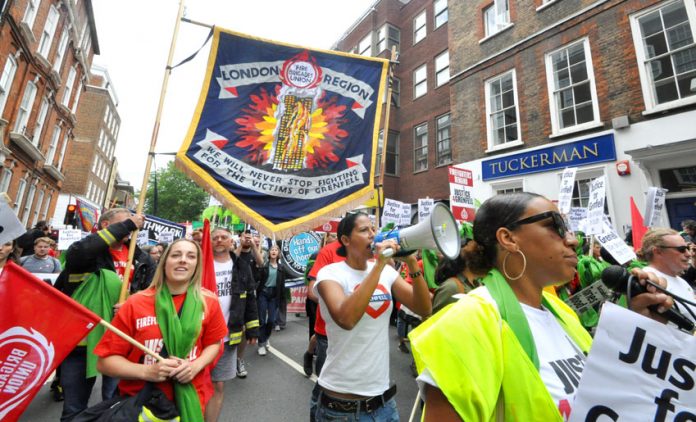
FIREFIGHTERS were not to blame for the stay-put strategy in the Grenfell Tower, fire expert Dr Barbara Lane told the Inquiry, it is the refurbishment, she insisted, which was to blame for the spread of the fire which claimed the lives of so many men, women and children.
Dr Barbara Lane is the Leader of Fire Safety Engineering at Arup. Responding to her evidence given to the Grenfell Tower Inquiry, Fire Brigades Union (FBU) general secretary Matt Wrack said: ‘Dr Lane explained how the principles of fire protection work in high rise residential buildings and how the stay-put policy arises from the design and construction of the buildings.
‘Dr Lane also revealed a host of failings in what was done at Grenfell Tower, including the use of combustible cladding and faulty fire doors. In our view, this inevitably put firefighters in an impossible position on the night.’
The Grenfell Tower, before it was refurbished in 2011, Dr Lane explained, was completely fireproof. However, the refurbishment, Dr Lane said, resulted in a litany of failures. Fire doors failed, gas pipes were exposed, windows were ill fitted and surrounded in flammable material, flammable cladding was fitted, flammable insulation and inadequate fire lifts meant that disabled people had no chance of escape.
Sakineh Afraiabi lived on the 18th floor of Grenfell Tower was partially sighted and got around using a tri-walker. She was one of those who had no chance of escape. Her daughter, Nazanin Aghlani who spoke at the Inquiry earlier this month, said her 65-year-old mother was deprived of her ‘human right to escape’.
Dr Lane said lifts in the tower were sub-standard, fire doors had not been replaced and combustible material was fitted around windows. Dr Lane also said the lifts had no escape hatches, making them unsuitable for the evacuation of disabled people.
She said the ‘very basis’ of the policy – telling people to stay in their flats during a fire – only worked alongside other protection measures. But the standards firefighters relied on ‘failed’ at 01:26 GMT.
The hearing was told that Grenfell Tower was completed in 1974 and had 19 different sets of works on it up until 2017. But a number of the additions or refurbishments did not comply with regulations, according to Dr Lane. She said the lifts in the building were not up to the standard for firefighters, despite having been refurbished in 2005.
The doors were not as fire resistant as they needed to be and did not have a secondary power supply. She told the Inquiry: ‘Fire doors are a crucial element of the stay-put strategy, as they represent an opportunity for weak spots to form in the fire-resistant partitions that separate a flat fire from occupants, either on the floor where the fire has started or occupants in the flat above the floor the fire has started.
‘Fire doors are, therefore, a building regulations requirement as a passive fire protection measure. Faulty fire doors mean faulty compartmentation and compartmentation is the primary basis of the stay-put strategy.’
Dr Lane also said the dry rising mains in the tower – through which firefighters pump water to tackle fires in high-rise buildings were also not suitable for a building of its height. She said the dry riser loses effectiveness as the height of the building increases and relies on good water pressure to work against gravity.
But eventually, the lack of water pressure means it cannot operate effectively. Buildings more than 50m in height should have a pressurised tank already in the building for firefighters to use, yet Grenfell Tower, measuring 67.3m, did not have one.